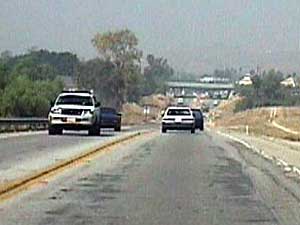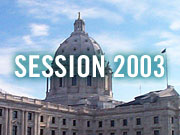Audio
Photos
Resources
Your Voice
| |||||||||||||||||||||||||||||||||||||||||||||||||||||||
Safe at higher speeds?
April 29, 2003
 |
| Speed limits on two-lane highways in Minnesota could rise to 65 mph under a bill being considered in the Legislature. (MPR file photo) |
Duluth, Minn. — State law says the absolute maximum speed on two-lane highways is 55 mph. Sometimes the state's Department of Transportation sets the speed lower -- on curves, or coming into a town. But MnDOT can't set the limit higher than 55 mph. That's up to the Legislature.
Most people break the speed limit. The average speed people really drive on many state highways is quite a bit higher than 55 mph. So state lawmakers are thinking about changing the speed limit on rural, two-lane state highways to 65 mph.
Rep. Marty Seifert, R-Marshall, authored the House version of the bill. He drives three hours to get to the Capitol. He says nearly everyone he sees is going faster than 55 mph.
|
It reflects the reality of how people are driving right now.
- State Rep. Marty Seifert, on proposal to increase speed limits |
"Quite honestly I think a slower speed limit provokes more accidents," Seifert says, "because people are trying to pass the slow people and are therefore creating head-on collision potential. So I would argue that trying to reflect reality is better than the pretend speed limit that we have now that 90 percent of the population is ignoring in rural Minnesota."
Some people disagree with Seifert. They say higher speeds lead to more crashes. But highway engineers say that's probably not true. The engineers say the number of accidents will stay about the same. But they also say the number of deaths will likely increase because crashes will be more violent at higher speeds.
Dan Brannan, traffic safety specialist at MnDOT, says cars have gotten safer over the decades. He says they handle better, have better tires, and have safety equipment like seatbelts and airbags.
"The one thing that hasn't changed with time, though, is we still have the human frailty," Brannan says. "We are people, we are human organisms, and it's just the law of physics that if that speed is too high, a human body can't take that impact."
About 650 people died in traffic accidents last year in Minnesota. If you figure those deaths per mile driven, Minnesota's highway death rate is lower than the national average. In fact, Minnesota has one of the lowest fatality rates in the country. North Dakota and South Dakota have death rates a little higher than the national average, and both states have 65 mph speed limits on rural highways.
|
If everybody traveled less than 20 mph, there would probably be no fatalities. But that's not reasonable.
- Dan Brannan, MnDOT traffic safety specialist |
Rural two-lanes are the deadliest highways. In Minnesota, people drive many more miles in cities and towns than they do on country highways. But three-fourths of the deaths happen on two-lane highways outside of town.
Lower speeds might mean fewer deaths. But that's not the only consideration. Dan Brannan says state law dictates that speed limits will be "safe and reasonable."
"The legislators feel that a faster speed limit is more reasonable," Brannan says. "If we were to look at safety only, and say, 'OK, what's completely safe?' we know for a fact that if everybody traveled less than 20 mph, there would probably be no fatalities. But that's not reasonable."
Brannan says the government in Sweden launched an intiative called "Vision Zero." The goal is zero deaths on highways. The Swedes have spent lots of time and money to make roads and cars safer. They've put crushable barriers in front of bridge uprights, and gotten rid of steep-sided ditches next to roads. On roads that can't be death-proofed, they've lowered the speed limit to 45 mph.
Simply lowering speed limits doesn't do much. Studies show that drivers ignore them. Traffic engineers say the limits have to be enforced, and drivers need to believe the speed limits are reasonable.
Rep. Marty Seifert says speed limits can't be set solely on the principle that "slower is safer."
"Well if that's the case," he says,"we should have a speed limit of 40 mph."
Seifert says he's not in favor of "big government," or the state being "a nanny" to its citizens. And he says higher speed limits just make sense.
"I think that it reflects the reality of how people are driving right now," he says.
Seifert's bill is working its way through committees in the House. A companion bill is moving through the State Senate.
If the bills become law, MnDOT will study the entire highway system, mile by mile, to determine a safe speed for each stretch of road. That's what MnDOT already does, with one difference -- some highways would end up with a 65 mph limit instead of the current 55 mph.
A MnDOT spokesman says it's difficult to speculate, but a good portion of two-lane state highways would probably be approved for a 65 mph daytime speed limit. The new speed limits would go into effect in the summer of 2004.
|
News Headlines
|
Related Subjects
|

